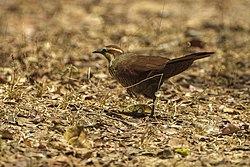| Mesites | |
|---|---|
 | |
| Subdesert mesite (Monias benschi) | |
| Scientific classification | |
| Domain: | Eukaryota |
| Kingdom: | Animalia |
| Phylum: | Chordata |
| Class: | Aves |
| Clade: | Columbimorphae |
| Order: | Mesitornithiformes Wetmore, 1960 |
| Family: | Mesitornithidae Wetmore, 1960 |
| Genera | |
 | |
| Respective ranges: brown mesite in orange, white-breasted mesite in green and subdesert mesite in blue | |
The mesites (Mesitornithidae) are a family of birds that are part of a clade (Columbimorphae) that include Columbiformes and Pterocliformes. [1] They are somewhat small-bodied, flightless or near flightless birds endemic to Madagascar. All the species of this clade are listed as vulnerable.
